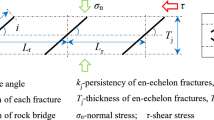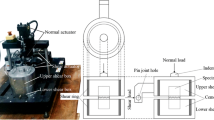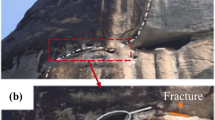Abstract
Among the constitutive models for rock fractures developed over the years, Barton’s empirical model has been widely used. Although Barton’s failure criterion predicts peak shear strength of rock fractures with acceptable precision, it has some limitations in estimating the peak shear displacement, post-peak shear strength, dilation, and surface degradation. The first author modified Barton’s original model in order to address these limitations. In this study, the modified Barton’s model (the peak shear displacement, the shear stress–displacement curve, and the dilation displacement) is validated by conducting a series of direct shear tests.







Similar content being viewed by others
References
Amadei B, Saeb S (1990) Constitutive models of rock joints. International symposium on rock joints. A.A. Balkema, Leon
Asadollahi P (2004) Modeling Rockbolts and Shotcrete in tunnels excavated through jointed rock and comparison with an empirical method, MSc Thesis. University of Tehran, Tehran
Asadollahi P (2009) Stability analysis of a single three dimensional rock block: effect of dilatancy and high-velocity water jet impact, PhD dissertation. University of Texas, Austin
Bandis SC, Lumsden AC, Barton NR (1983) Fundamentals of rock joint deformation. Int J Rock Mech Min Sci Geomech Abstr 20(6):249–268
Barton N (1971) Estimation of in situ shear strength from back analysis of failed rock slopes. Int Symp Rock Mech Rock Fracture, Paper II-27, Nancy
Barton N (1972) A model study of rock joint deformation. Int J Rock Mech Min Sci 9:570–602
Barton N (1973) Review of a new shear strength criterion for rock joints. Eng Geol 7:287–332
Barton N (1976) Rock mechanics review: the shear strength of rock and rock joints. Int J Rock Mech Min Sci Geomech Abstr 13:255–279
Barton N (1982) Modelling rock joint behavior from in situ block tests: implications for nuclear waste repository design. Office of Nuclear Waste Isolation, Columbus, OH, 96 p, ONWI-308, September 1982
Barton N, Choubey V (1977) The shear strength of rock joints in theory and practice. Rock Mech 10:1–54
Boulon M (1995) A 3D direct shear device fortesting the mechanical behaviour and the hydraulic conductivity of rock joints. In Rossmanith HP (ed) Proceedings of mechanics of jointed and faulted rock, p 407–413
Brady BHG, Brown ET (2004) Rock mechanics for underground mining. Kluwer, The Netherlands
Desai CS, Fishman KL (1991) Plasticity-based constitutive model with associated testing for joints. Int J Rock Mech Min Sci Geomech Abstr 28(1):15–26
Fox DJ, Kana DD, Hsiung SM (1998) Influence of interface roughness on dynamic shear behavior in jointed rock. Int J Rock Mech Min Sci 35(7):923–940
Gens A, Carol I, Alonso EE (1990) A constitutive model for rock joints, formulation and numerical implementation. Comput Geotech 9:3–20
Goodman RE (1976) Methods of geological engineering in discontinuous rock. West, New York
Grasselli G, Egger P (2003) Constitutive law for the shear strength of rock joints based on three-dimensional parameters. Int J Rock Mech Min Sci 40:25–40
Homand F, Lefevre F, Belem T, Souley M (1999) Rock joints behaviour under cyclic direct shear tests. In: Amadei K, Smealie Scott (eds) Rock mechanics for industry. Balkema, Rotterdam, pp 399–406
Homand F, Belem T, Souley M (2001) Friction and degradation of rock joint surfaces under shear loads. Int J Num Anal Meth Geom 25:973–999
Huang X, Haimson BC, Plesha ME, OIU X (1993) An investigation of the mechanics of rock joints-Part I: laboratory investigation. Int J Rock Mech Min Sci Geomech Abstr 30(3):257–269
Hutson RW (1987) Preparation of duplicate rock joints and their changing dilatancy under cyclic shear. Northwestern University, Evanston
Hutson RW, Dowding CH (1990) Joint asperity degradation during cyclic shear. Int J Rock Mech Min Sci Geomech Abstr 27(2):109–119
ISRM (1978) Suggested methods for the quantitative description of discontinuities in rock masses. Int J Rock Mech Min Sci Geomech Abstr 15:319–368
ISRM (1985) Suggested methods for determining point load strength. Int J Rock Mech Min Sci 22(2):51–60
Jaeger JC (1971) Friction of rocks and stability of rock slopes. Geotechnique 21:97–134
Jafari MK, Amini Hosseini K, Pellet F, Boulon M, Buzzi O (2003) Evaluation of shear strength of rock joints subjected to cyclic loading. Soil Dyn Earthq Eng 23(7):619–630
Jafari MK, Pellet F, Boulon M, Amini Hosseini K (2004) Experimental study of mechanical behaviour of rock joints under cyclic loading. Rock Mech Rock Eng 37(1):3–23
Jing L (1990) Numerical modeling of jointed rock masses by distinct element method for two and three-dimensional problems. Lulea University of Technology, Lulea
Jing L, Stephansson O, Nordlund E (1993) Study of rock joints under cyclic loading conditions. Rock Mech Rock Eng 26(3):215–232
John KW (1970) Civil engineering approach to evaluate strength and deformability of regularly jointed rock. Proceedings of 11th Symposium on Rock Mechanics, p 68–82
Kana DD, Fox DJ, Hsiung SM (1996) Interlock/friction model for dynamic shear response in natural jointed rock. Int J Rock Mech Min Sci Geomech Abstr 33(4):371–386
Ladanyi B, Archambault G (1969) Simulation of the shear behaviour of a jointed rock mass. The 11th symposium on rock mechanics, Berkeley, p 105–125
Lee HS, Park YJ, Cho TF, You KH (2001) Influence of asperity degradation on the mechanical behavior of rough rock joints under cyclic shear loading. Int J Rock Mech Min Sci 38:967–980
Leichnitz W (1985) Mechanical properties of rock joints. Int J Rock Mech Min Sci Geomech Abstr 22(5):313–321
Miller RP (1965) Engineering classification and index properties for intact rock. PhD Thesis, University of Illinois
Olsson R, Barton N (2001) An improved model for hydromechanical coupling during shearing of rock joints. Int J Rock Mech Min Sci 38:317–329
Patton FD (1966) Multiple modes of shear failure in rock. The 1st Congress of the International Society of Rock Mechanics, Lisbon, p 509–513
Plesha ME (1987) Constitutive models for rock discontinuities with dilatancy and surface degradation. Int J Num Anal Methods Geomech 11:345–362
Qiu X, Plesha ME, Huang X, Haimson BC (1993) An investigation of the mechanics of rock joints-part II: analytical investigation. Int J Rock Mech Min Sci Geomech Abstr 30(3):271–287
Saeb S (1990) A variance on Ladanyi and Archambault’s shear strength criterion. In: Barton S (ed) Rock joints. Balkema, Rotterdam, pp 701–705
Samadhiya NK, Viladkar MN, Al-Obaydi MA (2008) Three-dimensional joint/interface element for rough undulating major discontinuities in rock masses. Int J Geom 8(6):327–335
Wang JG, Ichikawa Y, Leung CF (2003) A constitutive model for rock interfaces and joints. Int J Rock Mech Min Sci 40:41–53
Wibowo J (1994) Effect of boundary conditions and surface damage on the shear behavior of rock joints: tests and analytical predictions. University of Colorado at Boulder, Boulder
Wibowo J, Amadei B, Sture S, Price RH (1993) Effect of boundary conditions on the strength and deformability of replicas of natural fractures in welded tuff: data report. Sandia National Laboratories, Albuquerque, New Mexico
Zubelewicz A, O’Connor K, Dowding CH, Belytschko T, Plesha ME (1987) A constitutive model for cyclic behavior of dilatant rock joints. 2nd international conference on constitutive laws for engineering materials, pp 1137–1144
Acknowledgments
Simone Adotto and Marco Invernizzi conducted this research as part of their MS theses over a 6-month period spent at the University of Texas (UT) at Austin when they were sponsored by the Polytechnic of Turin, Italy. Professor Daniele Peila, DITAG, Polytechnic of Turin co-advised Simone Adotto and Marco Invernizzi and found the funds necessary for supporting their stay at UT Austin.
Author information
Authors and Affiliations
Corresponding author
Rights and permissions
About this article
Cite this article
Asadollahi, P., Invernizzi, M.C.A., Addotto, S. et al. Experimental Validation of Modified Barton’s Model for Rock Fractures. Rock Mech Rock Eng 43, 597–613 (2010). https://doi.org/10.1007/s00603-010-0085-6
Received:
Accepted:
Published:
Issue Date:
DOI: https://doi.org/10.1007/s00603-010-0085-6




